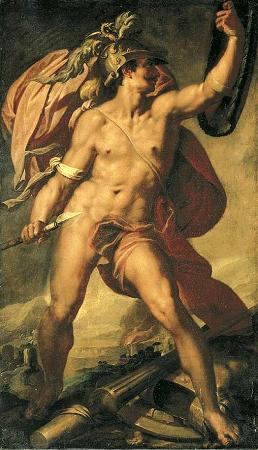Mars / Ares. In ancient Roman religion and myth, Mars was the god of war and also an agricultural guardian, a combination characteristic of early Rome. In art, he is commonly represented as a powerful, muscular figure often adorned in armor and armed with weapons such as a sword, spear, or shield. He is typically depicted with a stern or fierce expression, embodying the qualities of aggression and strength associated with warfare. In many representations, Mars is accompanied by symbols of war, such as a helmet, a battle standard, or even mythological creatures like the she-wolf or vultures. In classical art, Mars is frequently portrayed alongside other deities, especially Venus, symbolizing the duality of love and war. This theme is prevalent in works such as The Mars and Venus by Sandro Botticelli and The Venus and Mars by Paolo Veronese, where the contrast between the two gods emphasizes the interplay between love and conflict. During the Renaissance and Baroque periods, Mars’s imagery became more elaborate, often depicted in dynamic poses that convey movement and action, reflecting the ideals of heroism and valor. Artists like Gian Lorenzo Bernini portrayed Mars with a more dramatic flair, capturing the emotional intensity of battle. In modern interpretations, Mars has been represented in various ways, sometimes taking on allegorical or symbolic roles to comment on the nature of war and its consequences. His representation in art continues to evolve, reflecting societal attitudes towards conflict, masculinity, and heroism throughout history. Mars was second in importance only to Jupiter and he was the most prominent of the military gods in the religion of the Roman army. Most of his festivals were held in March, the month named for him, and in October, which began the season for military campaigning and ended the season for farming. Under the influence of Greek culture, Mars was identified with the Greek god Ares, whose myths were reinterpreted in Roman literature and art under the name of Mars. But the character and dignity of Mars differed in fundamental ways from that of his Greek counterpart, who is often treated with contempt and revulsion in Greek literature. Mars was a part of the Archaic Triad along with Jupiter and Quirinus, the latter of whom, as a guardian of the Roman people, had no Greek equivalent. Mars' altar in the Campus Martius, the area of Rome that took its name from him, was supposed to have been dedicated by Numa, the peace-loving semi-legendary second king of Rome. Although the center of Mars' worship was originally located outside the sacred boundary of Rome, Augustus made the god a renewed focus of Roman religion by establishing the Temple of Mars Ultor in his new forum. Although Ares was viewed primarily as a destructive and destabilizing force, Mars represented military power as a way to secure peace, and was a father of the Roman people. In the mythic genealogy and founding myths of Rome, Mars was the father of Romulus and Remus with Rhea Silvia.
more...













